Features (articles)
The Kakeibo and Japanese household budgeting tools

A few kakeibos, and Japanese womens' magazines with budgeting-oriented articles. Look for these words: 家計 (household finances), 貯める (save money), 家計簿 (household finance ledger).
To kick off Frugal Food month, here is an article from the archives about Japanese household budgeting tools, which was supposed to be the start of a series - but then All Hell Broke Loose around Chez Maki, and the series sort of got forgotten. Well, the series will be revived this month, so in case you missed this one, here it is!
(Original intro: So why is there a money management article on a food site? Well, I think that the subject of our money is on a lot of people's minds these days, and food spending is a major part of that. An it's about Japan, and I know a lot of you read this site because it brings you bits of interest about my homeland. So, I hope you'll enjoy this little derail.)
Many people worldwide are concerned these days about the economy. While it's difficult for us as individuals to influence factors like what our financial institutions do, we can control where our money goes. While this topic is not directly about food, I thought it might be interesting to see how Japanese people handle household budgeting.
Why look at what Japanese people do? For one thing, Japan went through a severe economic correction (aka the "bubble economy") in the late '80s, largely in part due to overvalued real estate and resulting defaults on loans, which lasted well into the '90s and even fundamentally changed the way Japanese society works. While the current Japanese stock market, yen, and banks are on a wild and bumpy ride just like the rest of the world, individuals (except for those who invested in stocks, currencies and such) on a whole seem to be a tiny bit less worried than people in North America or Europe. This may be because saving rates in Japan are amongst the highest in the developed world, estimated to be around 25% of income (though that has fallen from previous savings rates of 30 to 35%; in contrast, the saving rates in the U.S. average around negative 0.5%), or simply because household budgeting skills have been talked about for quite a long time.
The wife is in charge of the household budget
In the West, money is considered to be the domain of males. This is not the case in Japan. In a typical Japanese household, the wife (who may or may not work outside the home) is firmly in charge of the household finances. She decides on how the money is spent, how to plan for big ticket purchases, even in many cases how money is invested. Financial products are often marketed with 'cute' themes, to appeal to a female audience. (See the cute kakeibo in the picture above).
The kakeibo, the household finance ledger
The 家計簿 (kakeibo) is the essential tool used by any money-savvy Japanese household budget manager. Kakeibo literally means household finance ledger. You can buy all kinds of kakeibo (here are the Amazon Japan search results for 家計簿). While there are several kakeibo software packages, Excel templates and the like, hand-written kakeibo are still popular. Many magazines aimed at housewives include a giveaway version as a supplement in their December issues, for use in the coming year.
A typical kakeibo has:
- A monthly summary page, where monthly income is noted, and monthly budgets and savings/loan repayment goals are set.
- Weekly pages (or 2 pages per week) with expense and income categories on the left, and daily columns.
- A section for planning for irregular or unexpected expenses
- A yearly summary section.
A truly diligent budget manager/housewife diligently keeps up her kakeibo every day, noting down items in each budget category, but there are alternative kakeibos and kakeibo methods out there for lazier people. Here's the cover of a kakeibo where the user can just stick on receipts for example.

I know that it's a lot easier to use personal finance software, and in a bank account, check, and credit/debit card reliant society like the U.S. for example, it may make better sense, especially if you can automatically import your information online. But there's something to be said for actually writing down amounts by hand too: it may give a more tangible sense of how you're spending your money.
Focus on food costs
One thing that all kakeibos focus on is food costs, since food spending is both one of the biggest budget categories and one of the easiest areas to cut down on costs. Rather than lumping every eating purchase and activity into 'food' as a category, the kind of purchase or activity is sub-categorized too. Traditional kakeibo categorize food purchases by the nutritional type: carbohydrates, meat and fish, dairy and eggs, vegetable and fruit, etc. It also serves as a way to see if food purchases are balanced health-wise. More recent, easier kakeigo may divide it into larger categories like regular food, fun food (snacks and drinks), eating out, and so on. There are kakeibos that combine budgeting functions with meal planning and recipe tracking too.
Cash envelope budget management
In Japan, most people get paid by direct deposit (checks are rarely used by anyone) and pay things like utility bills electronically. But for other household spending, cash is still the king. One often recommended budgeting method is to draw out the cash you need for a week or a month, depending on how you manage your budget, and physically divide it into envelopes that are marked by spending category. Once the cash in an envelope is gone, it's gone - no cheating afterwards. It's a remarkably effective method - it almost becomes a game to try to have as much money left over at the end of the month. And having your money in your hand, rather than as numbers on a screen or a piece of printout paper, makes it much more tangible.
Another cash-oriented saving trick (which isn't that uniquely Japanese really, but is very popular there) is the coin saving method. At the end of every day, extra coins are put into a piggy bank or a jar, and when there's enough accumulated, it's either used for buying something extra or deposited into a bank account. Japanese ATMs even have coin deposit slots.
This is just a brief overview of the budget management methods discussed ad infinitum in Japanese magazines, books and blogs. Next time, I'll talk about my favorite Japanese how-to-manage-money book for money dummies like me. (Update: Here's my review of the book.)
Filed under: essays japanese budgetingKouya Dofu or Kohya Dofu, Freeze Dried Tofu
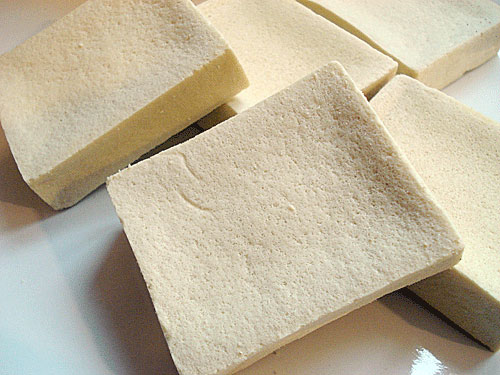
I've talked a little about kohya dofu or kouya dofu (高野豆腐)in the past, but I thought I'd describe it in detail so that I can refer back to it when I use this very versatile Japanese pantry staple in recipes.
Kouya dofu is freeze dried tofu. It's a long lasting pantry staple of most Japanese households. It comes in plastic packaging, usually 5 to a pack, like so:
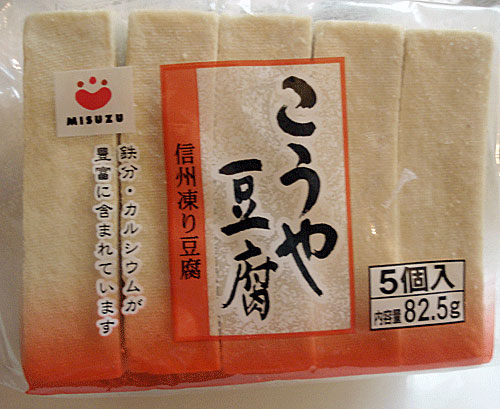
Each square is about the size of a business card, and about 1cm or 1/2 inch or so thick. Each kouya dofu square is about 90 calories. They look like dehydrated squares of bread, or one of those sponges that you soak in water to reconstitute and use. The packets require no refrigeration.
Indeed, it is a sponge - a block of tofu that's been reduced to its cell structure. It's a very old traditional preserved food, that probably got invented by accident when someone left out some tofu in the winter and it froze solid. It's made by repeatedly freezing and thawing tofu, until all the moisture can be extracted.
Usually, kouya dofu is used by reconstituting it first. The easiest way is to soak it for a while in boiling water to cover. When the water has cooled down enough for the tofu to be taken out and genty squeezed, it's ready to use. It swells up to about 3-4 times its original size.
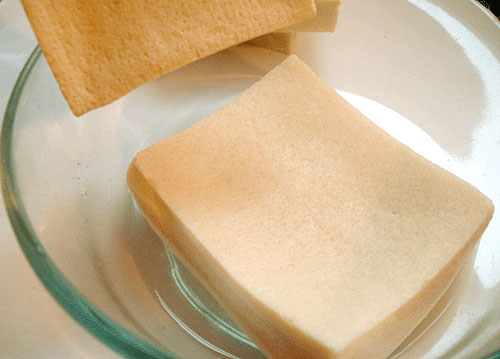
From here, you can just cut it up and use it in soups or stews. You can also marinate it. It has a more dense and firm texture than regular tofu, and like regular tofu it soaks up any flavor it is soaked or cooked in. It's usually stewed in a standard japanse soy sauce - mirin - sake - dashi - sugar mixture.
Here I've cooked some reconstituted kouya dofu in the same way that I cooked frozen tofu cutlets, to make kouya dofu nuggets. But I didn't have to take the time to freeze and defrost regular tofu. The results are much 'meatier' than nuggets made with frozen regular tofu. You might even be able to fool some unsuspecting people into think it's some sort of meat....
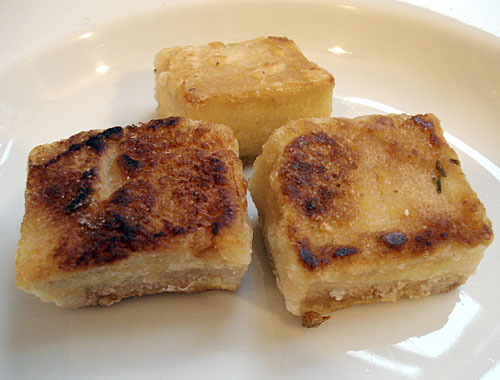
Another interesting way of using kouya dofu is to turn it into a powder by grating it or whizzing it in a food processor. The powder can be used instead of breadcrumbs, as a filler or binder in burgers and meatballs. This can be a good thing for celiacs and gluten intolerant people. The spongy texture soaks up any excess moisture and flavors. And of course, it provides and extra protain boost.
In Japan, kouya dofu is very cheap. Outside of Japan it can be more expensive, but the packet of 5 in the photo above was only $1.99 at Nara Foods in Port Washington, Long Island. So, look for it next time you are in a Japanese grocery store and give it a try, especially if you or someone you cook for has gluten allergies, or are vegan or vegetarian.
Filed under: japanese ingredients vegetarian tofu vegan

 (Photo by
(Photo by 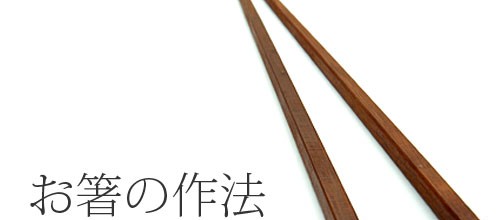
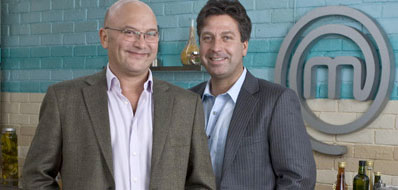

 Welcome to Just Hungry, where we serve authentic Japanese recipes and more! I'm
Welcome to Just Hungry, where we serve authentic Japanese recipes and more! I'm 












